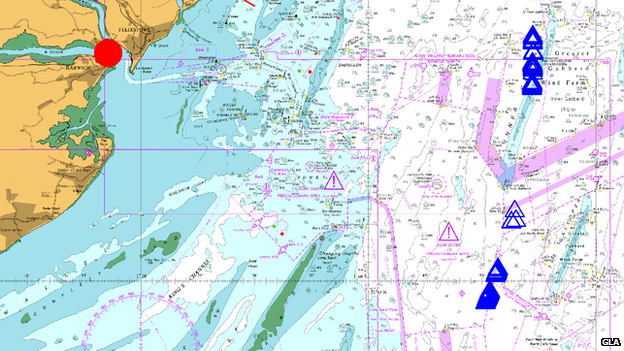Map illustrates 'Russian GPS' failure
- Published

A GLONASS receiver (red dot) on England's east coast gave position fixes in the North Sea (blue triangles)
The General Lighthouse Authorities of the UK and Ireland have issued a map illustrating the effects of last week's failure in "Russia's GPS" system.
Satellites of the GLONASS network experienced a half-day outage when bad data was uploaded to spacecraft.
map shows a GLONASS receiver at Harwich giving corrupted position fixes that were off by more than 50km.
The Authorities say the 2 April event is a timely reminder that alternatives to satellite navigation are essential.
The GLA themselves are supporting a system in the UK and Ireland called eLoran, which transmits long-range position, navigation and timing signals from a ground-based radio network.
Its primary use is for ships and others in the maritime sector, but there is a feeling also that eLoran could provide a robust back-up for GPS, GLONASS, and Galileo when it arrives.
Galileo is the European sat-nav system, which is in the process of roll-out.
A Royal Academy of Engineering (RAEng) report in 2011 found that the UK was becoming dangerously over-reliant on what are termed Global Navigation Satellite Systems (GNSS).
Use of space-borne positioning and timing data is now widespread, in everything from freight movement to synchronisation of computer networks.
The academy found that too few of these applications were able to lean on alternatives should the primary sat-nav signals go down.
Receivers needed to be capable of switching seamlessly between a variety of data sources, the RAEng expert panel argued.
"GLONASS is used by quite a lot of people, actually; the iPhone-5 can pick up its signals," explained Prof David Last, a consultant engineer and past president of the Royal Institute of Navigation.
"What we saw last week was many people being affected by the GLONASS failure even with receivers that were also picking up GPS.
"The lesson that comes out of this is not just that satellite-navigation systems are vulnerable, but that you don't get a protection by simply plugging in a second satellite-navigation system.
"You need something that is different and doesn't share common modes of failure," he told 91╚╚▒Č News.
- Published27 December 2012
- Published12 October 2012
- Published8 March 2011